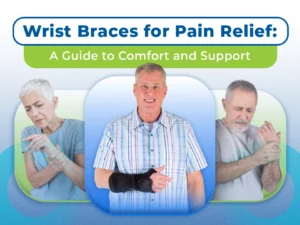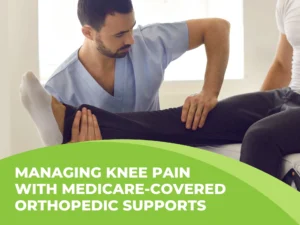As we age, it’s common to experience aches and pains in various parts of our bodies. Knee pain is a common complaint among seniors, which can significantly limit their ability to stay active. Staying active is important for seniors’ overall health and well-being, as it can improve physical function, reduce the risk of chronic diseases, and improve mood and cognition. Fortunately, there are several ways seniors can manage knee pain and stay active. In this article, we will discuss the causes of knee pain in seniors, the importance of seeking medical advice before starting an exercise program, low-impact strength and flexibility exercises for knee pain, and using assistive devices to manage knee pain.
Understanding Knee Pain in Seniors
The knee joint is one of the most complex and vulnerable joints in the body, and it is susceptible to wear and tear over time. Common causes of knee pain in seniors include osteoarthritis, injury, and inflammation. Osteoarthritis is a degenerative joint disease that occurs when the cartilage in the knee joint wears down, causing the bone to rub against the bone. Injuries to the knee, such as a torn meniscus or ligament, can also cause knee pain. Inflammation, such as rheumatoid arthritis, can cause swelling and pain in the knee joint.
Knee pain can significantly limit seniors’ ability to stay active. It can make it difficult to walk, climb stairs, or engage in other physical activities. However, it’s important to seek medical advice before starting any exercise program. A healthcare provider can evaluate the severity and underlying cause of knee pain and recommend appropriate exercises or treatments.
Low-Impact Exercises for Seniors with Knee Pain

Low-Impact Exercises for Seniors with Knee Pain
Low-impact exercises are gentle on the knees and help seniors stay active while managing knee pain. Walking is a great, low-impact exercise that can be done almost anywhere. Walking on flat surfaces is ideal for seniors with knee pain, as uphill or downhill walking can put extra strain on the knee joint. Swimming is another excellent low-impact exercise that can improve cardiovascular fitness and muscle strength without putting stress on the knees.
Running, jumping, and high-impact aerobics can put a lot of stress on your knees. Avoid these activities and opt for low-impact alternatives like rowing, or elliptical training. Cycling is also a low-impact exercise that can be done outdoors or on a stationary bike. The resistance can be adjusted to accommodate individual fitness levels.
Tai Chi is a gentle exercise focusing on slow, controlled movements and deep breathing. It has been shown to help improve balance, stability, and flexibility, which can help reduce knee pain. Gentle stretching and strengthening exercises can be beneficial for knee pain. Yoga and Pilates help improve flexibility, balance, and core strength, which can help reduce knee pain.
When starting a new exercise routine, it’s important to start slowly and gradually increase intensity. Seniors with knee pain should also warm up before exercise and cool down afterward. A warm-up can consist of stretching, walking, or light aerobic activity. A cool-down can include stretching and slow walking. Seniors should also listen to their bodies and stop exercising if they experience pain or discomfort.
Strength and Flexibility Exercises for Knee Pain
Strength and flexibility exercises can also help manage knee pain and improve physical function. Exercises that strengthen the muscles supporting the knee joint, such as leg lifts or squats, can help stabilize the knee and reduce pain. Leg lifts involve lifting one leg off the ground while standing and holding it for a few seconds before lowering it back down. Squats involve bending the knees while keeping the back straight and the feet flat.
Stretching exercises can also improve flexibility and reduce knee pain. Simple stretches, such as hamstring and calf stretches, can be done before and after exercise. Hamstring stretches involve sitting on the ground with one leg extended and reaching forward to touch the toes. Calf stretches involve standing with one foot in front of the other and bending the front knee while keeping the back heel on the ground.
It’s important to perform strength and flexibility exercises safely and effectively. Seniors should start with light resistance and gradually increase as their strength improves. They should also use proper form and technique to avoid injury. A healthcare provider or physical therapist can guide how to perform these exercises safely and effectively.
Using a chair or wall for exercise support can also help seniors maintain proper form and reduce the risk of injury. Additionally, seniors should listen to their bodies and stop exercising if they experience pain or discomfort.
It’s important to note that seniors with knee pain may benefit from a personalized exercise program created by a healthcare provider or physical therapist. These professionals can tailor an exercise program to an individual’s specific needs and goals, considering their medical history and other health conditions.
Incorporating strength and flexibility exercises into a regular exercise routine can help seniors manage knee pain and improve physical function. These exercises can also help seniors maintain their independence and quality of life as they age.
Read More: How To Determine Eligibility For Medicare Knee Brace Coverage?
Assistive Devices to Manage Knee Pain
In addition to low-impact strength and flexibility exercises, seniors with knee pain can also use assistive devices to manage their pain and stay active. Knee braces or compression sleeves can provide support and help reduce pain during exercise. Medical knee supports help relieve knee pain and increase mobility, giving you more confidence to go about your day. These devices work by applying pressure to the knee joint and can help improve stability and reduce swelling. Seniors should consult with a healthcare provider to determine if a knee brace or compression sleeve is appropriate for their individual needs.
Other assistive devices, such as canes or walkers, can help seniors stay active while managing knee pain. These devices support and help distribute weight away from the knee joint, reducing stress and pain. Seniors should choose a cane or walker that is the right height and provides adequate support.
Our Medicare-approved knee braces help with the following conditions
The type of orthopedic knee product you need will depend on the issue you’re experiencing. These braces support and stabilize the knee to prevent injuries or keep them from worsening. Under your doctor’s oversight, using a medical knee brace can assist with several problems, such as:
- Multiple sclerosis
- Osteoarthritis
- Cartilage/meniscus tears
- ACL/MCL injuries
- Tibia, fibula, or patella fractures
- Knee instabilities
- Ligament derangement
- Valgus and varus knee corrections
- Post-surgery recovery
- Tendon ruptures and more.
Our knee braces are universal in size and feature multiple range-of-motion positions to offer support and comfort to restore mobility. If you’re unsure what product is right for you or if you’re eligible for insurance coverage, Artik Medical Supply will provide the guidance you need. We can even communicate with your doctor to determine the best knee orthopedic brace.
In Conclusion
Knee pain is a common complaint among seniors that can significantly limit their ability to stay active. However, there are several ways seniors can manage knee pain and stay active. Low-impact exercises such as walking, swimming, and cycling can improve cardiovascular fitness and muscle strength without putting stress on the knees. Strength and flexibility exercises can also help manage knee pain and improve physical function. Seniors should seek medical advice before starting an exercise program and perform exercises safely and effectively. Assistive devices such as knee braces or compression sleeves can support and help reduce pain during exercise, and canes or walkers can help seniors stay active while managing knee pain.
Artik medical supply is committed to providing high-quality medical supplies to help seniors live healthier, more active lives. We offer a range of medical assistive devices, such as knee braces, compression sleeves, canes, and walkers, to help manage knee pain and improve mobility. We encourage seniors with knee pain to consult with their healthcare provider and consider using a knee brace to manage their pain while staying active. By staying active and managing knee pain, seniors can improve their health and well-being and enjoy a fulfilling and active lifestyle. Contact us today to check your insurance coverage and eligibility.








